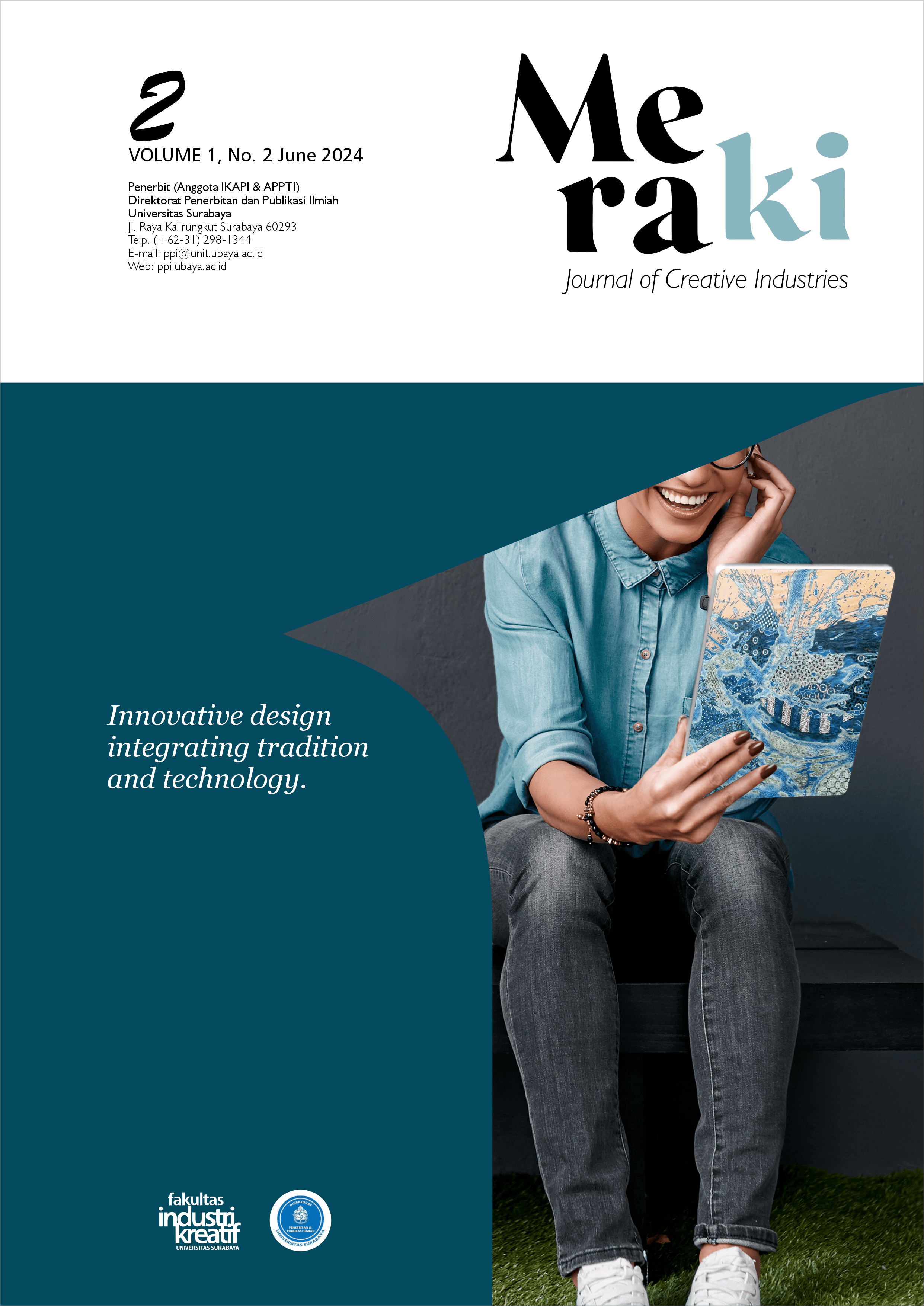Interactive NPC for Interactive Learning Media Of Indonesian Traditional Music
 Abstract Views:
162 times
Abstract Views:
162 times
 PDF Downloads:
85 times
PDF Downloads:
85 times
Abstract
In the age of digitalization, society has become increasingly accustomed to the utilization of electronic devices. This phenomenon has also had a discernible impact on the gaming market, with an estimated population of over 1.1 billion gamers across the Asia Pacific region. This figure is anticipated to continue its upward trajectory, particularly in the context of the ongoing pandemic, which has compelled individuals to remain at home and conduct their activities primarily online. Consequently, the adaptation of educational resources to align with this digital era is imperative. Within the scope of this research endeavor, we propose the development of an interactive Non-Playable Character (NPC) capable of responding to inquiries pertaining to indigenous musical instruments. To assess the efficacy of our work, we have implemented two distinct evaluation methodologies. Firstly, we have assessed the accuracy of the proposed NPC. Secondly, we have administered a questionnaire to gauge the degree of satisfaction experienced by users when acquiring educational content through our proposed NPC. The results of our evaluation indicate that interactive NPCs can indeed be employed, albeit with a relatively modest impact on enhancing the educational process.
Downloads
References
[2] D. Jamaluddin, T. Ratnasih, H. Gunawan, and E. Paujiah, “Pembelajaran daring masa pandemik Covid-19 pada calon guru: hambatan, solusi dan proyeksi”.
[3] D. Buckingham, “Do We Really Need Media Education 2.0? Teaching Media in the Age of Participatory Culture,” pp. 9–21, 2015, doi: 10.1007/978-981-287-326-2_2.
[4] J. T. Alexander, J. Sear, and A. Oikonomou, “An investigation of the effects of game difficulty on player enjoyment,” Entertain Comput, vol. 4, no. 1, pp. 53–62, Feb. 2013, doi: 10.1016/J.ENTCOM.2012.09.001.
[5] P. J. Aguilar-Cruz, “Understanding students’ engagement with a Serious Game to learn English: A sociocultural perspective,” International Journal of Serious Games, vol. 9, no. 4, pp. 137–152, Nov. 2022, doi: 10.17083/IJSG.V9I4.554.
[6] A. A. Yunanto, D. Herumurti, S. Rochimah, and I. Kuswardayan, “English Education Game using Non-Player Character Based on Natural Language Processing,” Procedia Comput Sci, vol. 161, pp. 502–508, Jan. 2019, doi: 10.1016/J.PROCS.2019.11.158.
[7] A. Dinakaramani, F. Rashel, A. Luthfi, and R. Manurung, “Designing an Indonesian part of speech tagset and manually tagged Indonesian corpus,” Proceedings of the International Conference on Asian Language Processing 2014, IALP 2014, pp. 66–69, Dec. 2014, doi: 10.1109/IALP.2014.6973519.
[8] C. P. C. Munaiseche, D. R. Kaparang, and P. T. D. Rompas, “An Expert System for Diagnosing Eye Diseases using Forward Chaining Method,” IOP Conf Ser Mater Sci Eng, vol. 306, no. 1, p. 012023, Feb. 2018, doi: 10.1088/1757-899X/306/1/012023.
[9] A. A. Pramesti, R. Arifudin, and E. Sugiharti, “Expert System for Determination of Type Lenses Glasses Using Forward Chaining Method,” Scientific Journal of Informatics, vol. 3, no. 2, pp. 177–188, Nov. 2016, doi: 10.15294/SJI.V3I2.7914.
[10] H. Nurdiyanto and H. Kuncoro, “EXPERT SYSTEM FOR MEASURING THE SUGAR-CONTENT IN SUGARCANE USING FORWARD CHAINING METHOD,” in 4th Asian Academic Society International Conference (AASIC), 2016, pp. 527–533.
[11] A. Al-Ajlan, “The Comparison between Forward and Backward Chaining,” Int J Mach Learn Comput, vol. 5, no. 2, pp. 106–113, Apr. 2015, doi: 10.7763/IJMLC.2015.V5.492.
[12] S. Ramdhan, P. Prayogo, and A. R. Azkia, “Media Pengenalan Alat Musik Tradisional Jawa Tengah Berbasis Multimedia,” JURNAL SISFOTEK GLOBAL, vol. 8, no. 2, Sep. 2018, doi: 10.38101/SISFOTEK.V8I2.199.
[13] D. Airlangga, “MEMBANGUN APLIKASI PEMBELAJARAN PENGENALAN ALAT MUSIK TRADISIONAL INDONESIA DENGAN KEMAMPUAN TEXT TO SPEECH BERBASIS WINDOWS PHONE”.
[14] R. G. Silaban and Y. Sukmayadi, “Utilizing Wordwall as a Learning Media Game-Based Traditional Music Instruments,” pp. 302–309, Sep. 2023, doi: 10.2991/978-2-38476-100-5_42.
[15] V. H. Satria and D. Herumurti, “Role-Playing Game as Learning Media To Support Online Learning,” Journal of Education Technology, vol. 5, no. 4, pp. 579–587, Nov. 2021, doi: 10.23887/JET.V5I4.39718.
[16] H. Yew Ken, J. Liew Suet Yan, M. Farris Iman Leong bin Abdullah, Y. Tang, and N. Prestopnik, “ReWIND: A CBT-Based Serious Game to Improve Cognitive Emotion Regulation and Anxiety Disorder,” International Journal of Serious Games, vol. 10, no. 3, pp. 43–65, Sep. 2023, doi: 10.17083/IJSG.V10I3.603.
[17] L. Kang, S. Luo, H. Huang, K. K. Purnamasari, and I. S. Suwardi, “Rule-based Part of Speech Tagger for Indonesian Language,” IOP Conf Ser Mater Sci Eng, vol. 407, no. 1, p. 012151, Aug. 2018, doi: 10.1088/1757-899X/407/1/012151.
[18] F. L. Fu, R. C. Su, and S. C. Yu, “EGameFlow: A scale to measure learners’ enjoyment of e-learning games,” Comput Educ, vol. 52, no. 1, pp. 101–112, Jan. 2009, doi: 10.1016/J.COMPEDU.2008.07.004.
[19] Soegiyono;, Album Alat Musik Tradisional. Proyek Pembinaan Media Kebudayaan, 1990. Accessed: Sep. 04, 2023. [Online]. Available: //pustaka.kebudayaan.kemdikbud.go.id%2Findex.php%3Fp%3Dshow_detail%26id%3D4296%26keywords%3Dalbum+alat+musik+tradisional
[20] F. Rahim, “Game Edukasi Pengenalan Alat Musik Tradisional di Indonesia Berbasis Android,” 2016.

This work is licensed under a Creative Commons Attribution-ShareAlike 4.0 International License.
- Copyright on articles is retained by the respective author(s), without restrictions. A non-exclusive license is granted to Keluwih: Jurnal Sains dan Teknologi to publish the article and identify itself as its original publisher, along with the commercial right to include the article in a hardcopy issue for sale to libraries and individuals.
- Articles published in Meraki: Journal of Creative Industries are licensed under a Creative Commons Attribution-ShareAlike 4.0 International license. You are free to copy, transform, or redistribute articles for any lawful purpose in any medium, provided you give appropriate credit to the original author(s) and the journal, link to the license, indicate if changes were made, and redistribute any derivative work under the same license.
- By publishing in Meraki: Journal of Creative Industries, authors grant any third party the right to use their article to the extent provided by the Creative Commons Attribution-ShareAlike 4.0 International license.

 DOI:
DOI:


